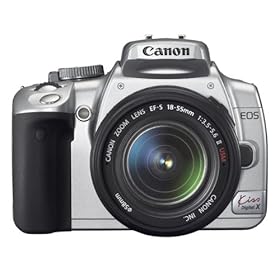 There is an interesting interview with Mr. Ohara, the director of Canon’s camera development center who talks about the development of and ideas behind the new Canon EOS Kiss Digital X (400D/XTi).
There is an interesting interview with Mr. Ohara, the director of Canon’s camera development center who talks about the development of and ideas behind the new Canon EOS Kiss Digital X (400D/XTi).
http://dc.watch.impress.co.jp/cda/dslr/2006/09/22/4641.html
Here is my summary in English. Note that this is not an official translation and it may or may not be entirely accurate. Use or believe it at your own risk.
– Canon started investigating dust reduction methods since 8 years ago in 1998 with the EOS D2000. By then, there were users wanting some way to reduce dust on the sensor. So Canon knew that they had to do something to alleviate the dust problem.
– Investigation of concrete ideas for dust reduction methods started 4 or 5 years ago. They decided that the system had to be very effective and reliable and not just a band-aid-type feature. Otherwise, they would not incorporate it.
– With the thin crystal plate (low-pass filter) in front of the sensor vibrating to shake off dust, there might be concerns about affecting the plate’s durability. So Canon spent quite a bit of time testing it and found that it was not a problem.
– There is no standard criteria to measure the effectiveness of a dust reduction system (effectiveness not mentioned in the camera specs). Like how much dust can be removed by the system. The effectiveness varies depending on the type of system. So how can users judge the effectiveness?
There are various types of dust. The dry dust particles fall off easily. However, oily dust such as those mixed with your sweat or oily skin, and sticky particles are difficult to shake off.
However, he thinks that the dust reduction system is effective enough on a practical level. To see how effective it is, the only way is to actually use it yourself and see. The effectiveness cannot really be quantified.
– Canon did not think that just shaking off the dust was enough. So they also incorporated the following four approaches for maximum overall effectiveness:
1. Minimize dust generation (from moving parts inside the camera such as the shutter curtains)
2. Minimize dust attraction (Anti-static coating)
3. Remove dust from the sensor (with shaking sensor and dust absorption material on the periphery)
4. Post-processing (removal of dust spots with software)
– Older cameras cannot take advantage of the post-processing method, even with a firmware update. This is because the distance between the low-pass filter and sensor is different in previous cameras. This distance is taken into consideration by the software when removing the dust spots. (This distance affects the size of the shadow on the sensor caused by the dust on the low-pass filter. The dust spots are actually shadows on the sensor caused by the dust particles on the low-pass filter covering the sensor.)
– As to whether the dust reduction system will be incorporated in other EOS D-SLRs, the answer seems to be yes. However, it may not necessarily be the same system used in the EOS Kiss Digital X (400D/XTi). They will keep developing and improving the dust reduction system or use any method which is more effective, easier, or cost effective.
– He says that, although it is a tight fit, it is “not impossible” to also install a vibrating crystal plate in front of the sensor for dust reduction in full-frame D-SLRs. Instead of having a cover glass, the first layer is already the low-pass filter (like with the EOS 5D) (which can vibrate). So dust reduction in full-frame EOS cameras may well appear.
– About the S/N ratio of the sensor as affected by the smaller pixel size (pitch), he says that the quality of the signal obtained from the sensor is exactly the same as the Kiss Digital N (350D/XT)’s, but not better.
The internal image processing is the same as the 350D, but since Picture Styles have been incorporated, the image might look different between the new and older cameras.
– For years, Canon has worked to improve the level of image detail, more so than just reducing noise. This also applies to the Kiss Digital X. It does not make sense to have more megapixels if it does not also obtain better image detail. Instead of relying on image processing to reduce noise, we go back to improving the design of the sensor and other analog components to improve the original signal.
– Users will probably not really notice the difference in image quality between images taken with an 8-meg and 10-meg sensor.
– DIGIC III has already been incorporated in Canon’s compact digicams, but not in the new Kiss Digital X. The development cycle is different for compact cameras and D-SLRs. Incorporating a new DIGIC circuit in a D-SLR would entail a wholesale change in the internal electronics.
In any case, the speed and response of DIGIC II is more than adequate for the new new Kiss Digital X. DIGIC III will be incorporated when the time comes, he says.
– The grip has been improved. The part where the palm of your hand touches the grip is fatter. There is also a thumb pad. They did not go to great lengths to improve the grip. However, they tried to make at least some improvement.
– The LCD monitor is bigger, and the AF sensor is the same as in the 20D and 30D. Compared to the Kiss Digital N, the AF sensor is more sensitive and precise. With 10 megs, the AF precision had to be improved.
– They did discuss switching to SD cards. However, CF cards currently have high (or higher) capacities and they are cheaper per megabyte. Yet they are aware of SD cards being more popular and more laptops having built-in SD card slots. So they will keep this open for discussion.
– Regarding lens stabilization in the camera body like Sony and Pentax, Canon plans to continue incorporating lens stabilization in the lens instead. This is more effective since the IS (Image Stabilizer) can be designed and controlled to suit each lens. It is more effective this way especially with longer lenses.
As to the question of having IS in both the body and lens, it would not be practical to invest in the development of both and to have the user bear the cost of both. With a body-based system, you cannot see the stabilization effects through the viewfinder. Thus, there are more advantages with a lens-based system. We hope to expand our IS lens lineup so more people can use it. (Seems to be a hint that cheaper IS lenses are forthcoming.)
– Final words: The Kiss Digital X looks similar to its predecessor. However, inside it is totally different. Instead of judging the camera by its looks and specs, you have to pick it up and see it for yourself. The image quality is also top-notch.
See black lens kit here
Black body only here
Related article:
Canon No. 1 in Dec. 2006





